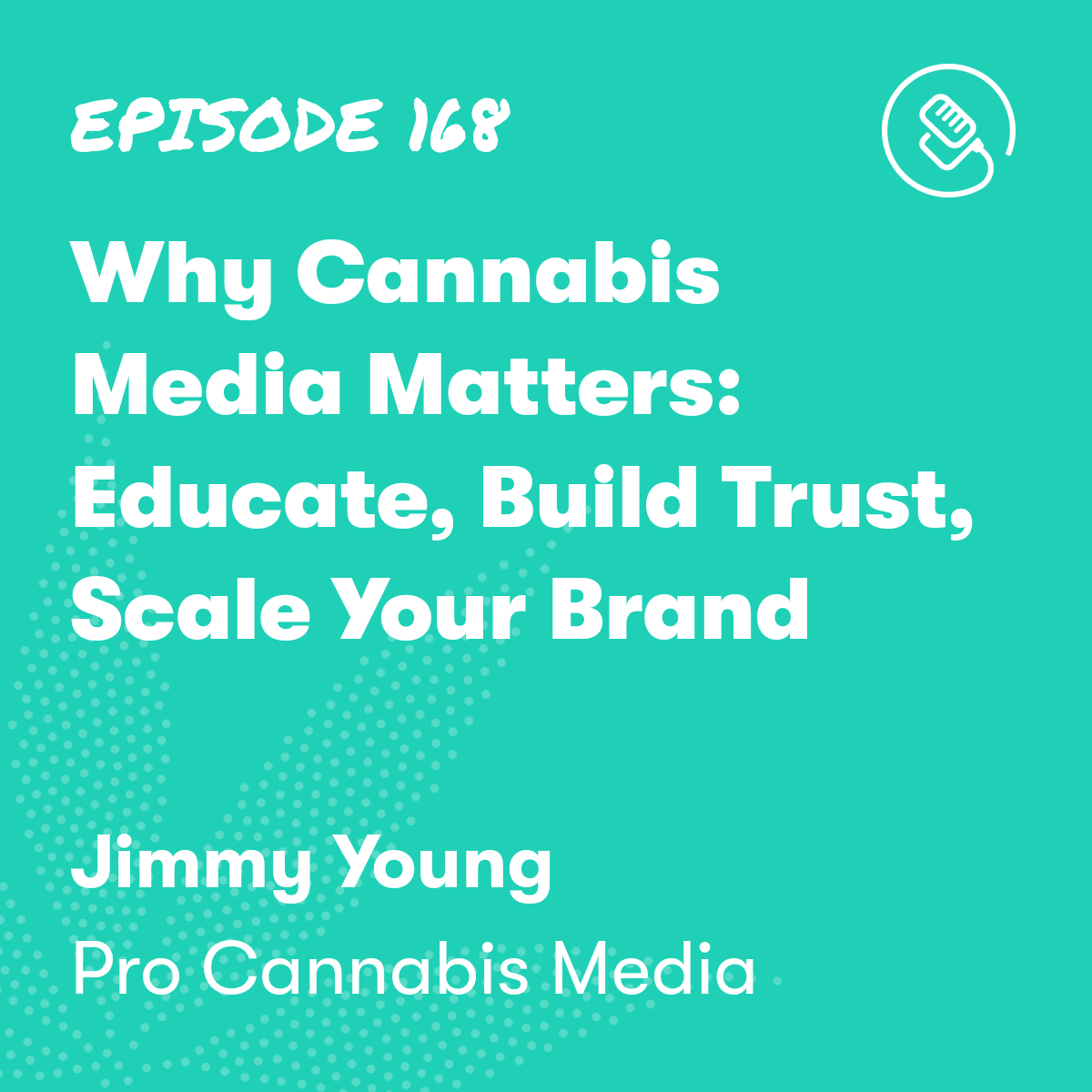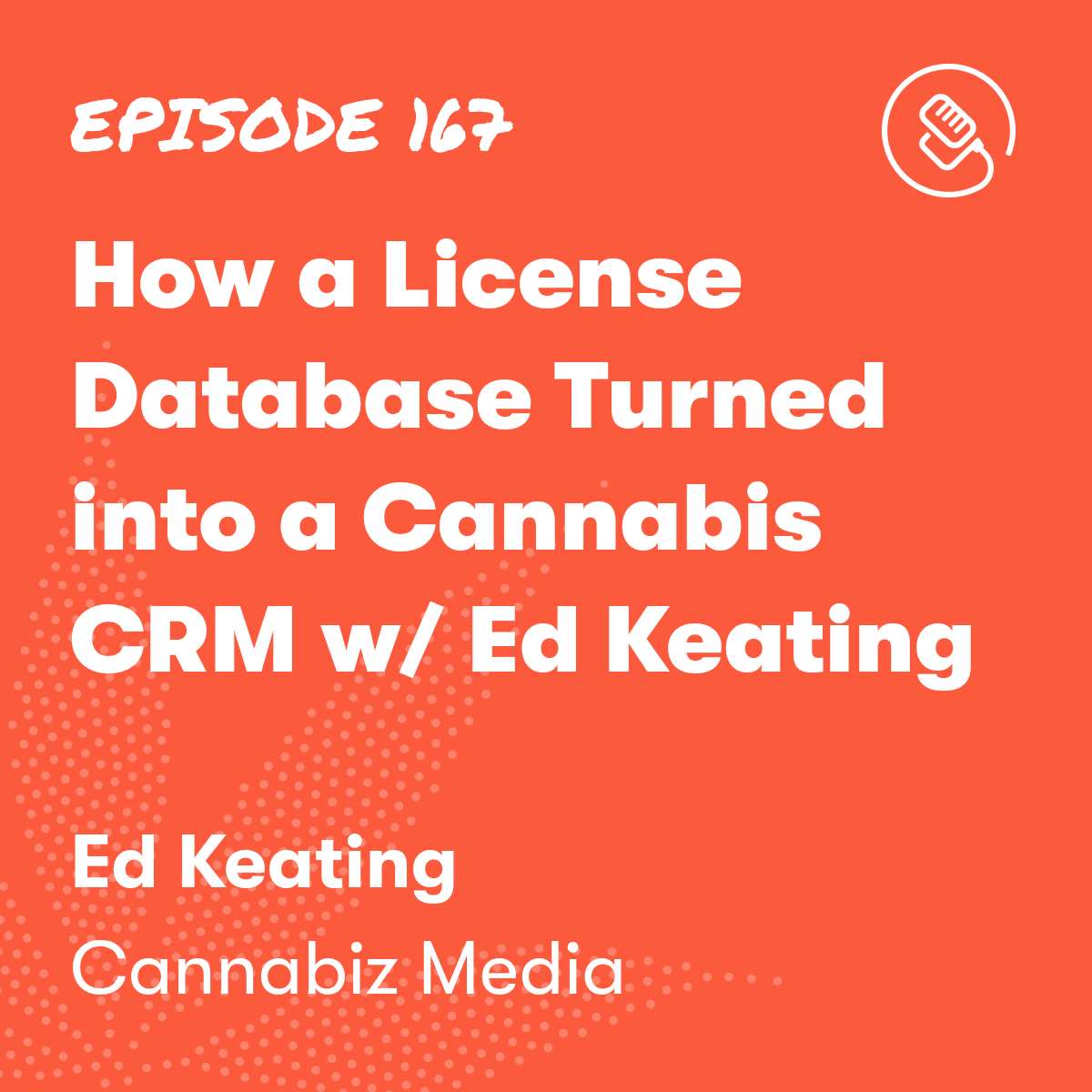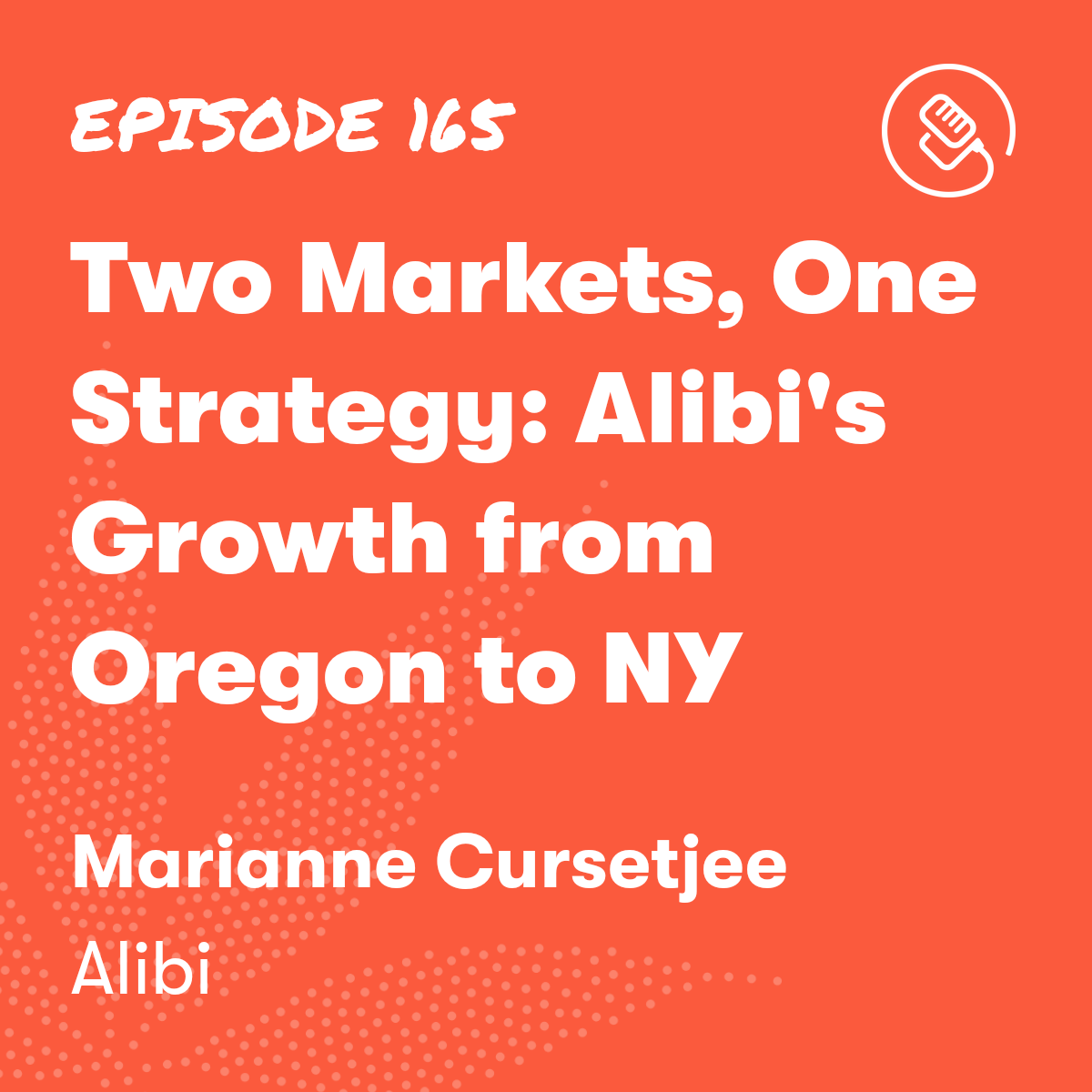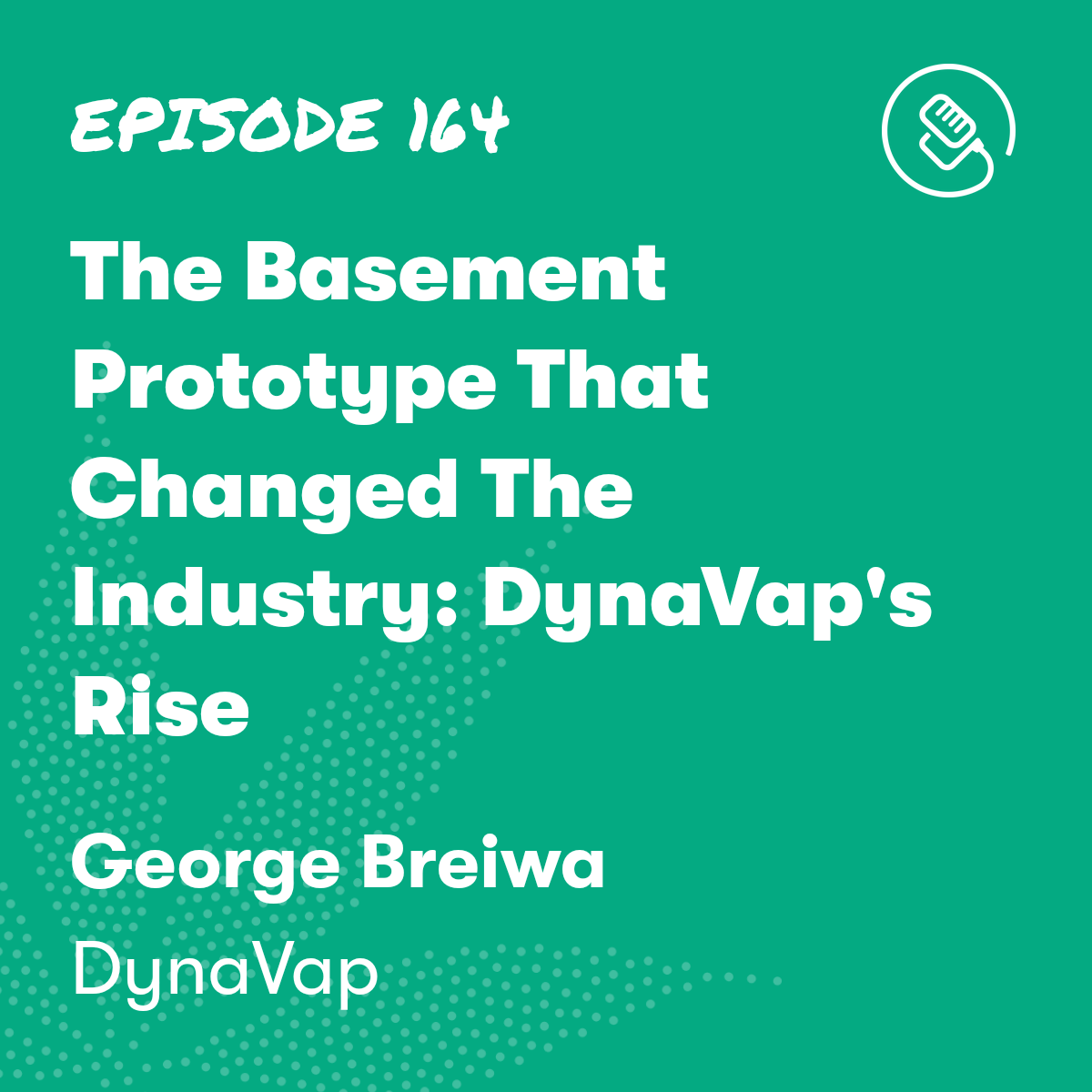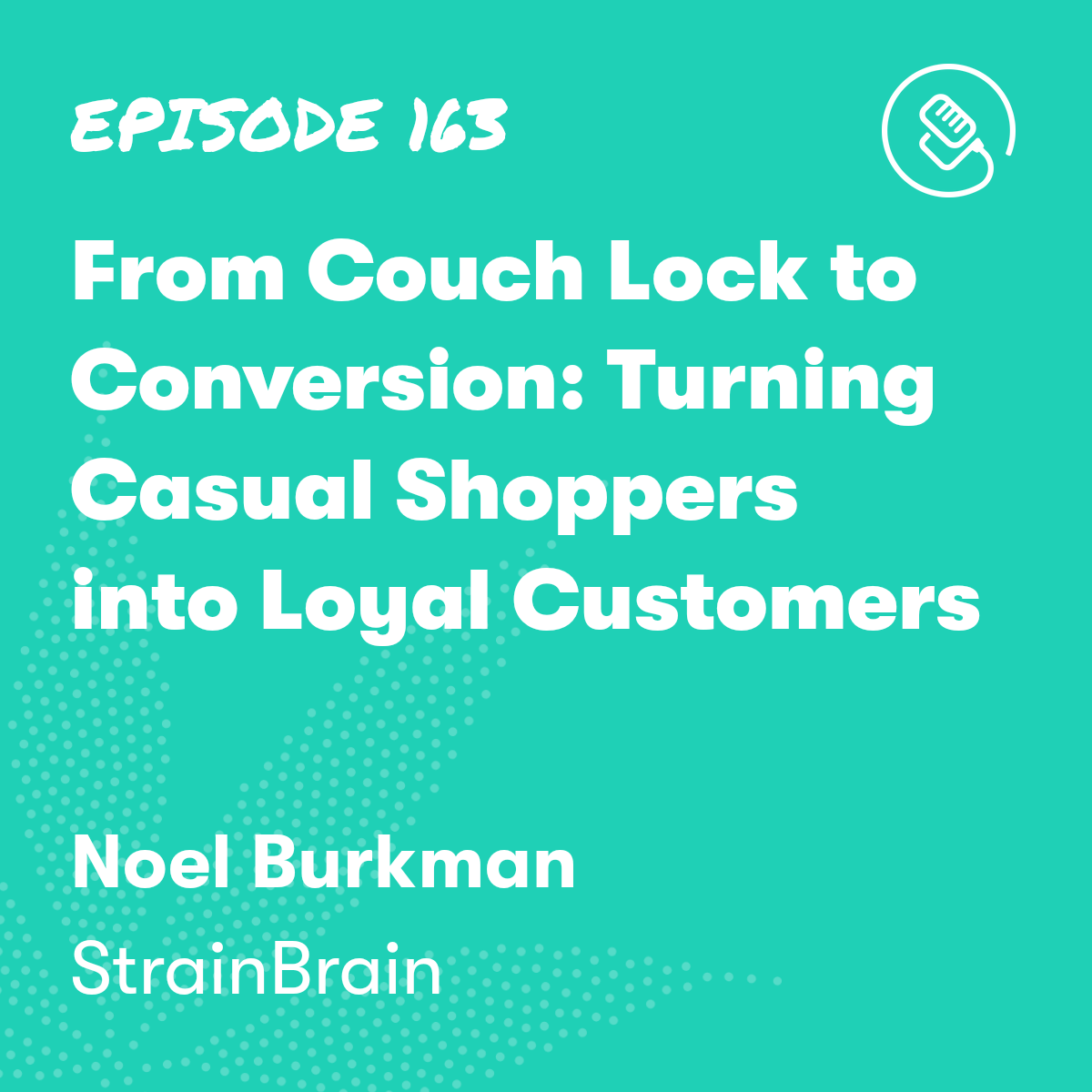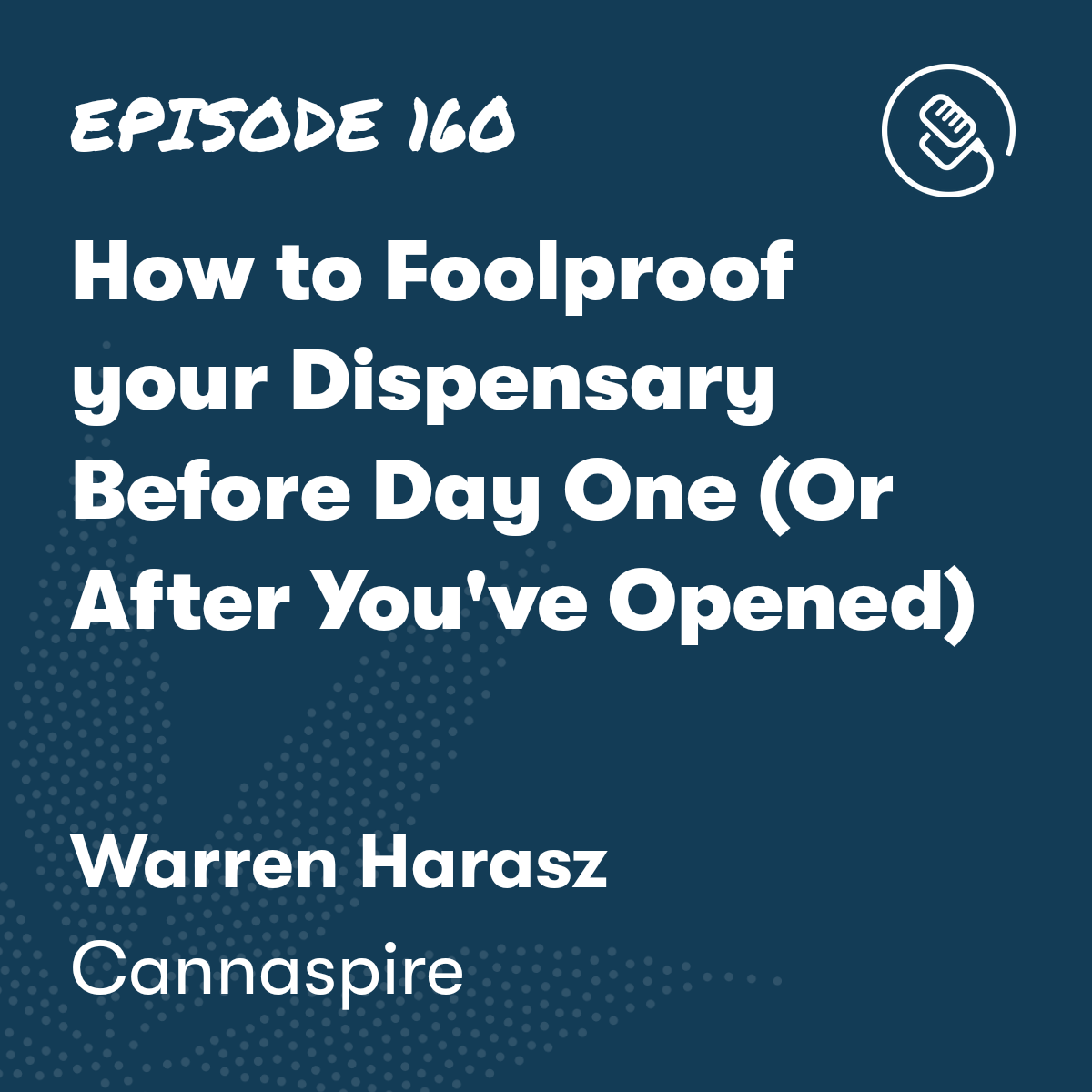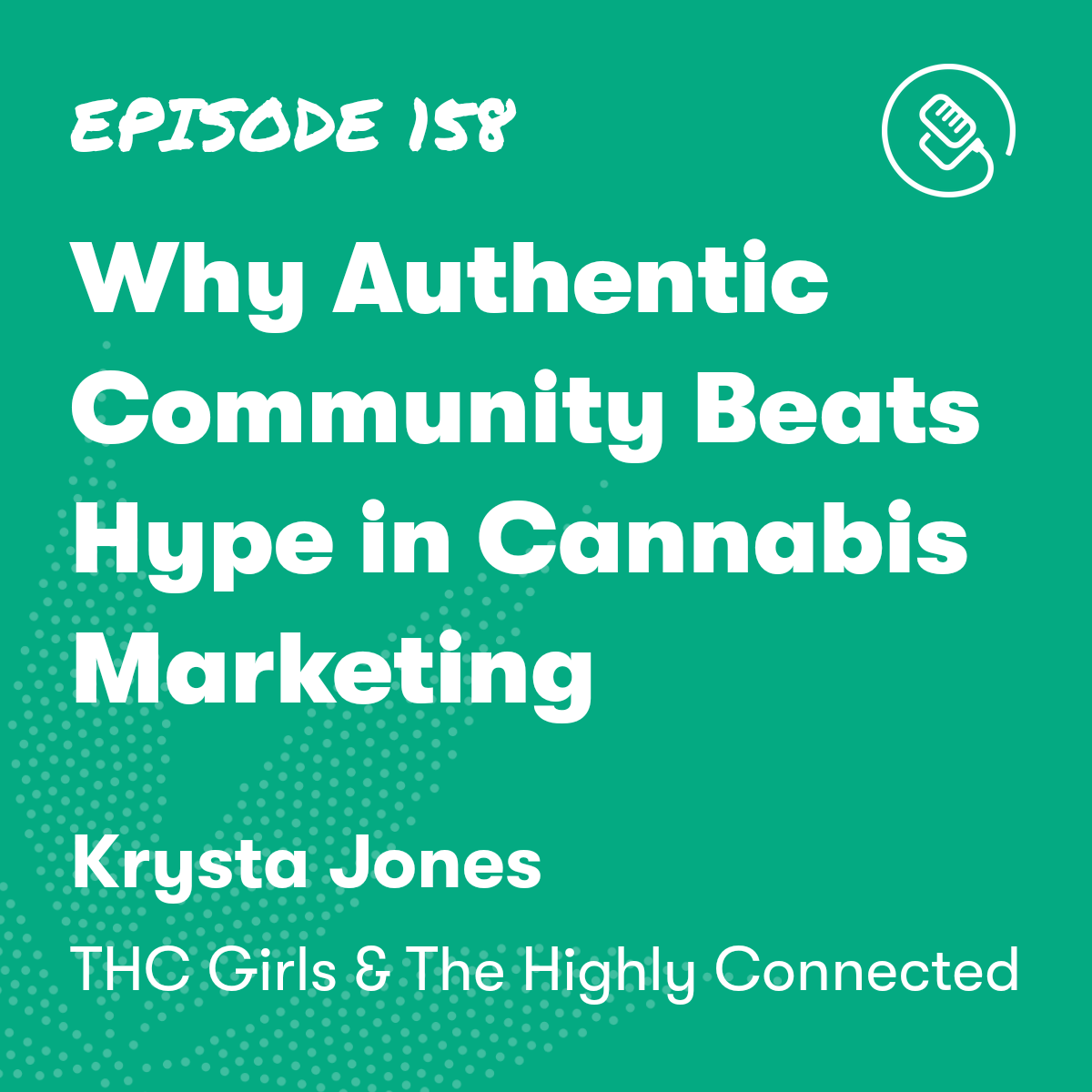

Creating In-store Digital Experiences with Amber Erickson
Episode Description

Episode Transcript
Tom Mulhern: Welcome to the show. Today on the show, I am speaking with Amber Erickson, who's the Head of Marketing at Seed Technology. Now, Seed Technology is helping cannabis dispensaries with the in store experience, so they're all about creating that amazing customer journey. That unique customer journey, helping customers that are walking into cannabis retail shops find what they need in a different way.
They're partnering with bud tenders in education. They've got all sorts of cool technology from displays to touch touchscreen to self-serve kiosks. And my conversation with Amber as a fellow marketing person, we talked a bit how to do marketing in such a restricted market.
And so, uh, I think you're gonna enjoy this conversation and let's dive right into the show.
Tom Mulhern: Amber Erickson is an experienced cannabis technology marketer. She's the head of marketing at Seed Technology, which is empowering dispensary owners and operators with digital signage and interactive solutions to decrease wait times, increase revenue, and reduce staffing costs. Formerly, she served as the head of content for cannabis POS provider Flowhub.
Amber has a BA in journalism from Boise State University and an MA in Holistic Health Studies from St. Catherine University. She's been recognized by the Content Marketing Awards in both editorial and marketing performance categories.
Seed's customer facing technology drives engagement, transactional velocity, and increased cart sizes at your dispensary. Their POS integrated software solutions are designed specifically for in-store use to give dispensary operators more control over the shopping environment and connect dispensary customers to products they'll buy. With Seed Technology, you can control every screen in every store from anywhere. So Amber, welcome to the Kaya Cast podcast. It's so awesome to have you here on the show.
Amber Erickson: Thanks for having me.
Tom Mulhern: It's great having you on the show. Tell me a bit about your background and how you, how did you end up in the cannabis industry?
Amber Erickson: I didn't look to get into the cannabis industry. I think a lot of people do. They're aspiring for that and looking for organizations that have openings, but mine was more. I did content marketing and I was looking to continue to do content marketing, and Flowhub had an open position. So it was kinda after applying that this question started being asked, and I had to reflect a little.
Why or what about the industry made me interested Because it was more the posting, the job, the role than it was the company or the industry. But after the fact it started to make a lot of sense. In my bio you mentioned my master's degree in holistic health studies, which is completely random.
And um, most of my focus was on plant medicine. Traditional herbs the, the weeds of the, of the world the, the dandelions and the things that grow everywhere that people don't pay attention to, but the medicinal value and the spiritual value of those plants. So cannabis fits perfectly into that kind of paradigm.
So it, it wasn't a, it wasn't a stretch. It's something I believe in as a plant medicine kind of capacity. So the answer became easy once I thought about it, but it wasn't intentional. I kinda accidentally ended up here and have stayed.
Tom Mulhern: Yeah. And what's one of the most like surprising things about entering the industry? Like, I mean, Having your background in some of that plant medicine, having your, background in marketing. Coming into the cannabis industry, has there been anything that's been really surprising that you're just like, Oh, that is not the way I thought it would be.
Amber Erickson: All of it kind of, you know, but, but none of it at the same time. I think that was part of the draw is that it's kind of new and, and interesting and you. Find creative ways to do things that other industries get to do typically, I think the one thing that really surprised me was just SEO and researching keywords and the lack thereof of information. All, you can search all the keywords and look for search volume and difficulty and all of those things that are typical, but the results are not there. It's, you know, zero to 10 and then well, I think people are actually searching for that. It's probably not zero to 10, but, you know, it has the word cannabis in it.
I kinda wish they just told you. We will not give you this information rather than making it look like there's information. So it's, there's a lot more educated guessing happening in the SEO space specifically for cannabis that, that I've seen so far. And then also just.
The concept of what people search for. If a dispensary owner is looking for accounting software, are they going to Google and searching accounting software? Are they searching cannabis accounting software? And understand the kind of, the nuances of a niche kind of market. That is also a broader topic, I think has been one of the things to, that's interesting to wrap your head around of just what are people looking for?
What are those actual terms? How do they find the information that they're looking for? That is specific, to dispensaries, not just specific to retail organizations or, something more broad. Cause they, they can get information from that more broad retail kind of industry. But there's a lot of nuances that it's more specific.
Tom Mulhern: You've been working now in the industry for a while in marketing and you know, that's one of the struggles that a lot dispensaries have is building their brand and seo.
But before we jump into that, I wanna know, so you're the head of marketing at Seed Technology, so what does Seed Technology do?
Amber Erickson: Seed is in store, customer facing digital technology. And that's a lot of, a lot of words, but it's really specific to that in-store experience. So the TV menus on the wall the promotional graphics, you know, come to our upcoming events, the interactive tablets and the uh, touchscreen kinds of kiosks.
So we, we kind of categorize our, our products or what we offer into that TV menu, interactive tablets, self-service as three separate, but related kinds of products. But really it is just the in-store and people can configure those things to be an endless solution of what that looks like in an actual store kind of environment.
But we are not website, we're not eCommerce, we're not POS we're not something that the dispensary employees use. We are that customer facing technology in store. And I know you're gonna ask why or, what value those tools bring and. Partially I always think about it as educating, informing, inspiring.
So maybe it's letting your shoppers know your hours, your daily deals, changes in policy, changes in law, new products you're carrying. But then there's also the you know what products you have in stock. Your menu should only show them the things you actually have, so there's not a weird, interaction when they get to the counter and out you don't those things. But you can also brand videos and, other types of media to help them. Understand who you are, why they should shop with you, what you carry. So there's a lot of kinda reasons why digital solutions in store work.
But they're also good for the consumer. They know where to look. They know where to find the information that they want it, if they're sitting in a waiting room for a while, maybe there's something interesting playing or, something to look at, something to do while they're waiting. So there's a lot of reasons and Traditional retail has been going this direction for a long time.
Interactive displays, making people have something that they can engage with, be entertained by. It makes the experience more than just walking into a store, talking to a person, creating a transaction. Operators now care about the customer experience.
What is it like for them? Are they having a good time? Are they getting the products they need and want and desire, and do they leave feeling happy and satisfied and taken care of? So in store technology allows you to create the type of experience you want to create for your shopper.
Tom Mulhern: You have tablets and touchscreen, tell me a bit about that. Like that customer journey of having a tablet in hand, cuz I know being able to see what the product's about and add stuff to the cart or how does that work? I guess I'm kind of just guessing at, at how it work. Talk to that cuz that's something new I haven't seen before.
Amber Erickson: The self-service kiosk concept is relatively new for us as an industry, not so much in, in other industries, of course, but the way Seed works is it's not just an option of ordering, there's also an opportunity for customers or, or shoppers to do a, a consultation quiz.
I'm looking for relaxation. I'm going to, go to bed or go to a concert or whatever and kinda go through a series of steps to understand and then they can find which products would most align with what they're looking for. You know, If it's sleep and relaxation, maybe they're gonna get something with higher CBD or a CBN component, maybe an edible or a pre-roll.
And so there's an opportunity for them to understand what products you that you carry that could support what they're looking to get out of their cannabis experience. So that's, one kind of component. Or if they know exactly what they want, they can step right up. Navigator around, find the product they're looking for, add it to their cart.
And one thing that's unique about the way Seed does help service is we feel strongly in, the Amazon effect of the related products component. So as you add a product to your cart, let's say it's a cartridge, you then will see related products. So it could be related, based on effect, it could be related based on product type.
It could be related meaning that specific dispensary wants to promote a certain thing, and that can show is one of your options, but having that you may also like and being able to just hit a button to add it to your cart is a powerful way to not only upsell, but to introduce people to new products that they maybe didn't know, that already fit some sort of criteria of what the product they already have is.
Tom Mulhern: Have you seen a growth in revenue for dispensaries with the ones that have these self service kiosks, technology built in compared to the traditional where it's, just adding it based on what the budtender knows.
Like is there, a significant growth in that revenue and those basket building opportunities with that self-service?
Amber Erickson: Yeah, we do have one customer in Massachusetts who consistently reports a 26% increase in cart size specific to the shoppers using self-service as an option. So they are one of those stores that has it, it's an option. Customers can go with a bud tender, they can go to self-service, and so those who choose a self-service option do have significantly larger cart sizes.
So the recommendation component and the self-service is a way to explore on your own does have that proven impact on the cart size.
Tom Mulhern: Are there other benefits of having that digital experience in the cannabis buyers journey? You talked about educating customers and cart building, but what are some of those other benefits of having that digital experience?
Amber Erickson: I think from the customer's perspective, having the option is nice. Some people won't want self-service and others do. You know? So having the ability for consumers to have different ways to engage with their favorite stores, I think is an important way just to meet modern consumers where they are.
We're used to having that technology at the grocery store. I can decide, do I wanna wait for the 10 items or less line, or do I have a cart full? And I don't really wanna scan all this myself cause it's annoying, or am I in a hurry? Do I not wanna talk to anybody that day? There's a lot of reasons why people would choose to interact with somebody or not.
And so I think having self-service as an option is an important way to just meet consumers where they are within that specific, four walls of the brick and mortar.
But I think the other kinda reasons or benefits from an operator perspective is just throughput as well. So some people put self-service kiosks or stations or whatever you wanna call them, touchscreen devices in, in the actual bud room.
Four states that do have a separate waiting room is, you know what I'll talk about here, Some don't. So this is not as applicable, but you can have it in the budroom where somebody enters with a bud tenderer and has that option and maybe the bud tender's with them. It depends on the store flow and the operator, values and perspective of what that looks like.
But sometimes they're in the waiting room. So if it's stores that run a longer wait, they're busy areas, New markets, if you have an option in the waiting room The customer comes in, they check in with the front desk receptionist ID is verified and all of that. They're normally told to go sit and wait, and there's probably nothing going on.
They're just sitting waiting. Probably feeling kind of awkward if it's a newer experience, but if the receptionist could say, You can have a seat and wait for a bud tender, or you can step over here and browse our menu and even add things to the cart if you'd like. So again it's, it's an option.
It's something to do. It makes the weight feel less. It actually does decrease the wait time if that person can place their order before they even get into the budroom. And then once they step in, grab their products, pay, verify their id, and they're out the door. They can still ask the questions that they have.
There's not one kind of ideal workflow. It really depends what the store looks like, what state you're in, what your layout looks like, and all of these other factors.
Tom Mulhern: And now that's for wait times for those dispensaries where they have that waiting room. What about lines? Cuz lines used to be the big thing. Like, Oh, we've got a line out the door. You know, like a new dispensary opens up in town and there's a big line, but that's only good for the first day. How are you guys helping to kind of alleviate some of that pain of waiting in line. Do you have the technology there also solving that issue?
Amber Erickson: I think the line component similar to the waiting room wait component, maybe it's just the additional people outside. And yeah, on opening day it's great to have the media take a picture of a liner on the block. If that persists, those customers probably won't return.
Maybe they will, maybe there's something really interesting about you, you're doing something really special, there's an event or whatever. But generally, if I see a line like that, if most people see lines like that, they're not gonna wait. I don't wanna wait two hours to, to get a product.
It's just not gonna happen. So I think that's where being able to use technology, but also staff appropriately. So, we'll, we'll sidebar into another kind of related thought here, but , keeping the wait time is low and, you know, we hear customers say, Oh, well I have a 10 minute average wait time.
I'm happy with that. And always like, that's a long time. You know, customers don't want that long of a wait. My local grocery store always has a wait and it's maybe two people long, but it is the most annoying thing. I'm like, You need more staff. You need, Why do I come at these times? You know, it's like there's all kinds of thoughts as I'm waiting of what can I do next time to not have to wait?
It's, again, giving customers the option. Do you wanna get in and out or do you wanna engage with staff and take the time to ask questions and learn. And explore. And those who don't wanna wait, don't make 'em wait, Let 'em get in and out and they're gonna be happy. And then it also makes a line shorter for the people who don't mind waiting to have that one to one kind of relationship.
But also on, on the staffing kind of component is most stores are not busy all the time. Maybe there's a time of day or certain times of day. So staffing is incredibly difficult because you don't want to be understaffed so that you have huge weights when there is a, a little boom time, but you don't wanna be understaffed or you don't wanna be overstaffed.
You don't want people sitting around when you're slow. So it's trying to find the middle ground. And that is, one of those things that is also a use case for kiosks that maybe isn't as sexy or isn't as immediately tangible, but if you can keep your staffing more consistent, if it gets busier, encourage people to go that self-service line to take care of that quick burst of activity and then, you're not having an extra staff person cause it's technology sitting there serves as a pseudo bud tender.
And so I think there's something to that, to being able to keep that staffing costs not even low, but appropriate to what your actual, up and down of customers is.
Tom Mulhern: And that's one of the solutions that we've worked on cuz Kaya Push, the company we work for is a HR solution all in one tech stack that really is able to analyze. You're staffing and when do you need people there? When do you not like, when are your slow times? And you can dial into that data and then you can make adjustments accordingly if you have a kiosk like what you guys offer.
I think really technology can just, there's so many things out there that can make your business so much more effective. And it's just, you know, crawling through the weeds to find the things that is, that's gonna work right for your situation. And for. Your team and your level of comfort with technology.
Cuz there's probably some people that would maybe not feel comfortable having technology kind of running things. But we found that it's, it's helped people really optimize their staffing issues and get the people there when they need to be there.
Amber Erickson: Staffing right now is really hard. Like we have one customer, it's a single store operator. They chose to do away with bud tenders entirely. So the only way to order is to walk up and it's just a row of larger ELO touchscreen units.
And that's how you order. So they instead put more, they need fulfillers cause it's not, this isn't a vending machine, you know, you know, nor will it be. So they focus their staffing on the fulfillment, the inventory specialists a little bit more of between front and back of house, I guess you would call it.
So there that true frontline staff is not there. They couldn't find people. They couldn't find good people who stayed, but they chose that technology was a more consistent and stable experience and that they could more effectively find the fulfillers and the inventory specialists in, in their store.
And that's how they chose to do things. And maybe some people don't shop there because they don't like that experience and others do. But that's an option, And we're not saying that kiosks should necessarily. Replace your staff. This is a rare occurrence, but it is a way to kind of optimize and, you know, maybe instead of having five Bud tenderers on, for eight hour shifts to a day, maybe it's four in a kiosk and you're still sta saving on staffing and not impacting your customer's experience, but it's just a way to reallocate where those expenses go and where you can actually.
Impact things and to your point, finding the right solutions and technology that work for what you're trying to do, what you're comfortable with. What kind of vibe or experience you wanna create in your store. Some people want a no technology kind of experience, and that's totally fine. Some markets are a little bit more traditional, I guess maybe they use paper menus, they don't have TV menus. Maybe they have TV menus, but have no interest in self-service or more interactive kinds of technology. And that's that's the interesting place the industry is at right now too, is that there's kind of a, a polarized divide of people's comfort level and but then new markets come online and they come right to us for self-service. They're not even open yet. They're not even sure what their market's gonna be like. And they're like, we need self-service. So it's an interesting thing to watch the evolution of the new markets too, and where their heads are at around technology.
It's completely different than the legacy markets.
Tom Mulhern: And I've talked to retailers in kind of rural locations or areas that it's just hard to find those good people. And so they have a high turnover rate. They have a lot of trouble finding bud tenderers who are gonna work well with people.
Like it's having that flexibility to create that journey for each customer, like you said, that's so unique. Cuz there's, there's no ideal customer journey for a dispensary. From the moment a customer walks in, cuz everyone has different needs. Everyone has different ways they like to interact even with within a store.
And I think the past couple years have changed even the way we shop. And so, you know, I think you guys focusing fully on brick and mortar, fully in store but then adding that unique experience.
Now you've been in CannaTech for a while, so what are some of the things that you see as the future of CannaTech coming out or even some things that you've seen in the market that you're like oh, that's really, that's really cool that's something that you know, is gonna really change the industry.
Amber Erickson: I am interested in, you know, for a while there was the, the big players and there still continues to be the big players and a lot of people know who the options are.
If you asked a dispensary owner, who have you considered for TV menus, and they'll, they'll probably list off the, you know, the most popular two or three or five.
But then there's others, you know, And I think that's the thing where we're starting to see the others start to appear or the CannaTech brands that are more nuanced or do a specific kind of thing. It seems like we're getting to the place where other industries are, where now you can, find the small solution to, to solve a specific challenge.
Where before it was like eCommerce, POS, but now we're seeing the really specific of cart abandonment, you know, marketing solutions for cannabis dispensaries. And so I think these like really specific use case kinds of tools are starting to appear and I'm seeing more and more of, of those growing and, and interacting.
And then just the challengers to the larger companies, you know slew of eCommerce, players coming on the fields and, starting to see them gain traction. And it's easy with people like that. You'll never compete, the competitors to Salesforce, you're like, you'll never compete.
But there's space, you know, there's space for everybody. Not everybody wants Salesforce or HubSpot. Sometimes you want that smaller option that does more of the specific thing that you wanna do, or the new one that just came on the scene. Knowing and learning from the big players and doing something a little bit differently or finding a new way to adapt to it.
So I think that's kind of where we're at in CannaTech is the diversification of technology.
Tom Mulhern: Okay, we're gonna, we're gonna pivot here a little bit because we're both huge marketing nerds. You're the head of marketing. I'm in demand gen marketing here at Kaya Push. So what are some creative marketing tips you could give to dispensaries? Because I know, as we mentioned earlier, like marketing is hard in cannabis.
Like we've had so many ads taken off of, all these different social media platforms, Google, we've even had, you know, subreddit channels canceled that we tried making for this podcast. So what are some creative marketing tips that you've seen for dispensaries.
Amber Erickson: One of our customers in Michigan jars, I think they're 15 locations.
When I spoke to their retail marketing manager, she kinda gave an interesting use case. And this customer story is on the Seed website, by the way. So they use in-store digital as an advertising channel. So I think that is one place where dispensary marketers might be thinking external, how do I get my the word out?
Which you absolutely have to do because you have to attract new customers all the time. That's important. But there's also the retention component and how can I make sure the experience is great so that these customers that I've already spent the money or the time or they're whatever to. Want to keep coming back.
And so, uh, Katie from from Jars said, you know, our Instagram channel shows us as a brand, as a way of life, as a, I can see myself in them because it's young and it's modern and they're at, you know, electronic festivals and you know, they're skateboarding and it's crop tops and it's like a really young, vibrant, alive, diverse, kind of representation.
And there's nothing about their stores or their products. It's all this like way of life, it's lifestyle kind of account. And they probably still have things you that are flags and deleted, by the way, but, and so they create this experience through their outbound kinds of channels, social and text and all of that.
And, but they have limitations. But then if they can attract people in store, they use their screens as a way to continue that conversation so they're seeing the same types of individuals, the same types of graphics and, everything's created in house. So it's a really consistent experience for their branding.
It just feels, you know, like, oh, I, I thought I could see myself here. And now I'm in this store. I'm seeing these graphics and I'm talking to the team and I'm seeing the black and white aesthetic, and I, I like it here. You know, It feels good here. This is a good experience. There's a lot of products and all of that.
So they're using The normal external kinds of channels of marketing to draw people into the store. And then they're really leaning into that in-store experience using video and gifs and graphics to showcase and continue and create consistency around what their brand is, who they are, and who you are, as a customer that fits their ideal kinda target profile.
Tom Mulhern: That's so interesting, like building that culture cuz on Instagram or TikTok or any of these channels, you can have, you can build a culture, a brand, a look, an ethos without, actually putting the plant out there that's gonna get taken off or saying the word dispensary or whatever, cannabis that's gonna get taken off.
And then when they come into the store that it has to match that. And I think that's a good, that is a really good tip for those dispensary owners as they're thinking through their marketing strategy and building their brand. What you're doing externally has to reflect what you're doing internally.
If you have like a woodsy sort of feel in the store, then you know, you can, you can have plants on your Instagram or whatever and, and have that external with without putting stuff out there that's gonna get taken down.
Amber Erickson: Thinking of your in-store space as advertising, for lack of a better word, like yes, maybe there's posters or, or, you know, paper signage or table tents or things that you can do that are kind of typical retail ways to, you know, to give messages to customers in store. But there's also this channel up on the wall if they're sitting in the waiting room.
Watching, show them that new hot product that they might be there for. Show them what special you have today and put in a video that matches what they maybe saw on your Instagram or TikTok. Create that consistent experience and use it as a way to promote brands.
There's a, a whole thing at, you know, jars again, Katie's a a great example. They're doing really interesting things and they use their TVs to show custom graphics of, of media of the, the partner brand they're promoting that month. So maybe it's Kiva gummies and that's what's shown. And you know, customers are like, Oh, well those look interesting.
They can point to the TV and start a conversation around that media. You can sell that space. Maybe Kiva's gonna throw down some cash because they're getting impressions and views. Especially if you can have a way, you know, to prove that it was, it was shown and that there, so many traffic was coming through the stores.
There has to be that kinda give take. But beyond just advertising your own brand in store, you can use it as a channel to advertise other brands and use it as a way to drive revenue, influence behavior. And actually maybe counteract the cost of the technology in the first place by including those partner.
Tom Mulhern: Does your technology actually have the capability to do that? To put ads up there and to track some of the analytics of, if you put that Kiva gummy ad up there, You can track in the POS, Hey, We had a huge uh, upswing in sales for pineapple gummies, or whatever it is. Is your technology able to measure that and track that.
Amber Erickson: We have customers who, you know, this is one of the first things we'll we'll talk to with new customers of what are your goals, you know, We're not that signage provider who's just like, Yeah, put your menu up, Call it a day. Call us if there's any issues. You know, We're in there saying, What are you trying to achieve with this?
Is it transactional velocity? Is it, sales of certain products? And so we have a lot of customers who say, You know, I really want to increase the amount of of sales I have on this one product or this brand of products and say, Okay let's talk about that. How, you can feature them on your menu.
You can use custom graphics to show it. And we have had people, even just in the course of a week, measure the week with no promotion, the week of promotion, and having huge increases of sales of that specific product. So it is that, you see it, you ask for it kinda thing is kinda proven.
And I think one of them in Montana had a 4300% increase in sales week over week, just by promoting a product and it, they didn't really do anything. I think for this case it was just a custom, a graphic that showed the product and said now available or whatever that specific thing said, and just showing that on their screens and having it play through their kind of, rotation of images and menus and whatever they have playing on that specific channel or playlist.
It's a really easy thing to do to promote brands and easy to track one week to the next. What sales did you actually have? Did it make an impact? And it does. We see it all the time.
Tom Mulhern: When should a retailer start thinking about that, that digital experience? Like you say you work with them from like what do you want that experience to be instead of just Hey, let's throw a TV up there and put a USB drive and call it a day. it's a market that's, there's lots of new dispensaries opening up and then there's lot of ones that have been around for a few years, like when is the prime time to start thinking about that experience?
Amber Erickson: I'll give the non-committal answer of any time, really, but ideally, I think when you're. Designing your store, if you have a, an architect or a designer and you're talking through, you know, this will be a wall of products or waiting room will go here. I think that's the ideal time because then you're, you're being in that creative space to think through what is the flow? Where will customers go? Okay, here's the front door. They'll walk in. That's the, the ideal time I think to start thinking about these things.
But there's also no wrong time. Like some of the legacy markets, the, this technology wasn't really around when they started, or it was a very different version. When it was. And so I think for them, at some point, a lot of the legacy operators will say, You know what? I think we wanna do a revamp.
Things have changed. It's a little dark in here. Maybe we should, whatever. Or we're opening a new store, we're thinking about, Doing a little bit of a different design in our new store where we rebranding, we're seeing that all the time, or there's consolidation everywhere and then decide does that get retrofitted into this other brand?
Does it stay as it is? So there's really any time you can add them. I think the barrier is more of what space do you have currently to work with. If it's a tiny store, you maybe don't have that many options.
Maybe it's one TV or one self-service, or maybe there's a lot of space and but does like electricity run there? Can you put a TV on a wall? Is it a stable wall? You know, there's, There's all these other things in the retrofit you'd have to consider, but there's no real wrong time. And I think we, we see people regularly who say, You know what?
I've been doing paper menus, but it's just really time consuming. It's really expensive. At the end of the day, if you're printing those menus and cross checking your inventory every day, how long is that taking your staff? Every single day? And they're still wrong immediately. Human error is a real thing and so they think Well, you know, we're gonna try to.
Let's automate this. Let's use our POS inventory and have this be, more of a seamless thing. We're gonna, we're gonna put it on a TV behind, behind the counter. And that's something that's relatively easy to add to a store kinda after the fact.
Tom Mulhern: It's probably encouraging for, you know, a retail owner who's like, Oh man, we don't have any digital experience to know that it's not too late. Like it's never too late. Obviously the prime time to do it would be when you're first planning, but there's a lot of shops that are open and they're now going and things maybe have become stale, and then so it's not too late. It's not too late to change.
Amber Erickson: Self-service for a lot of people is kinda like, I don't know if my customers would use that. And so that's, you know, kind of another point to your question is, some states don't really know yet what's happening.
They haven't hit that, I don't know, I don't wanna call it a plateau, but there's like the early spike in some states you don't, It's just a lot of activity. So you don't really know would my customers use it? Would this work in my store? And so I think sometimes you might start out with it and find that things didn't really go the way you thought they were going to.
Maybe the flow didn't end up being what you thought it was gonna be. You were busier or slower or whatever those differences looked like. So I think there's always. A point and an opportunity or in a need to reflect and make changes as appropriate, and not even just in the way your store looks and performs and feels, but in your technology too.
Like these are things that we should just be reviewing all the time saying, does this still serve me? Does this still work for me? Should I look for other solutions? What's new? Things come online all the time and I think it's really common as humans. We often don't like to change. And I think the barrier of change is probably what you guys see a lot of too, of like, Well, I don't really like what I have, but we, we all know how to use it.
We're kind of used to it. It's fine. Like, I know it's hard, but as the, the tech scene especially grows and changes and, and we know what customers need to actually be successful and are building out those solutions to work for them. Think about considering your, your tech stack and what you should add, what you should delete, what you should change, what you should completely, you know, burn down and, and start fresh with.
That's a good habit to get into.
Tom Mulhern: So Amber, how can people find out more about the work you're doing at Seed or do you have any exciting new things coming up that you're gonna unveil soon? How can people engage with what you guys are doing?
Amber Erickson: The engagement question is, is easy. Get seed.io is our website. And being a content person at heart, that's where things are focusing, is being able to have resources and tools and, and tips and, and written form and, and video form to help dispensaries.
Tom Mulhern: You've got a great blog section on there, and we didn't even get into how your technology is impacting consumption lounges. But you just wrote a blog about that.
Amber Erickson: There's a lot. News and buzz around consumption lounges and opportunity growing in more states. So that is an area where our technology is being used currently. And so being able to do more there and tell that story more in the future is something that I'm focused on as well. Cause it's so interesting to take the tablet kind of component or the kiosk component, that's our, one of our customers, the Artistry.
They have a, a lounge, and customers are seated and they have a tablet on the table where they can browse the menu and place their own order and, goes to the back with the table number and your serves like a resturaunt kind of component and the menus curated based on the products and consumption types that are super appropriate to a consumption lounge, and. So that, like where our technology is being used in that way. And it's so interesting that, I of started by saying there's the TV kind of component and like the handheld or the tablet kind of component and then the larger kiosk touch screen kind of components.
And those kind of seem like we're talking about hardware, but it's really the tools that can fit on the hardware. But you can use them in so many different ways. And the consumption lounge application is actually a really interesting way to use a tool that kind of wasn't designed to be used that way, but it's perfectly applicable and I'm kind excited to see how that continues to change as the industry changes.
And the question about what's new is there's always new things coming and what I like about the way we're approaching it is it's less brand new, it's less, let's add this completely random thing and more of how can we make this better. So we're currently working on enhancements to the back end Seed Manager. It's called. It's the, that place where customers log in and upload their own media, create their own menus, decide which TVs play, which of the manage all your screens from anywhere. That's the seed manager, component of it.
So we're working on updates there just to make it more easy to use and modern and give them more opportunity for different templates, a different way for media to show. So some of the new menu designs are part of that and that's a little less of a, big new product, but more of just an enhancement.
And same thing with working on the self-service technology to make sure it's really serving and, meeting the needs of our customers and our customers', customers that, the actual end user. And then that kind of brand component too, of being able to make it super easy for our dispensary customers to decide
what they display and when and how it works and, make it work on behalf of them as well. Lots of things coming, but a lot of, just more of the same but better, doing it better.
And one more thing while we're talking about it is we're currently doing some research on how consumers feel about the in-store shopping experience. And that survey is open. The idea is just to understand how consumers feel about their in-store shopping experience. What do they like about it? What they not like about it? How did they pay? What were their preferences? How do they consume information? Do they wanna talk to the bud tender? What advice do they have for dispensary, operators?
So the intention is just to understand how they feel about the current state. And then be able to take that knowledge and information and apply it to what are we not thinking? What are consumers asking for that we're not really giving them as an industry? The actual survey for consumers is open now, and then towards the end of the year we'll have some research and data around that.
So I think that'll be a really interesting, an interesting exercise and I'm really excited to kind of see where, where that goes and, and what information we can capture from it. The survey lives at getseed.io/cannabis-consumer-survey, and it's, it's pinned at the top of our LinkedIn page as well.
Tom Mulhern: We'll have all the links to uh, your website, to your, your LinkedIn, everything, and encourage people to go fill out that survey because the data from that will really impact everyone in the industry.
Thank you so much, Amber. This was, This was fantastic hearing the unique things you do, but also kind of how retail owners can kind of rethink what they're doing and make their customer journey even better. So I appreciate the conversation.
Amber Erickson: Thanks for having me. I think there's, there's no right or wrong in this, you know, I think it all depends, but the tools are there to create the experience you wanna create.
Tom Mulhern: Again, I want to thank Amber from Seed Technology. We had such a great conversation and it's always fun to geek out with a fellow marketing nerd. I would encourage all of you listeners to go head over. If you're a cannabis customer, go over and fill out that survey about your in-store experience.
Because really that will help the market just be better. When we're able to dial in that customer experience, that digital experience of shopping for cannabis, finding what you need, finding what will really help benefit you and give you the experience you're looking for.
It's just gonna make the whole industry better. So head over to getseed.io to find out more. Also, while you're on your computer, go head over to kayacast.fm you can hear all of the episodes that we've released for the Kaya Cast. There's some great conversations that we've had and we have some great conversations coming up. So subscribe to the podcast in your favorite podcast player app so that you can hear all of the new episodes, the conversations we're having. And thanks again for listening.
